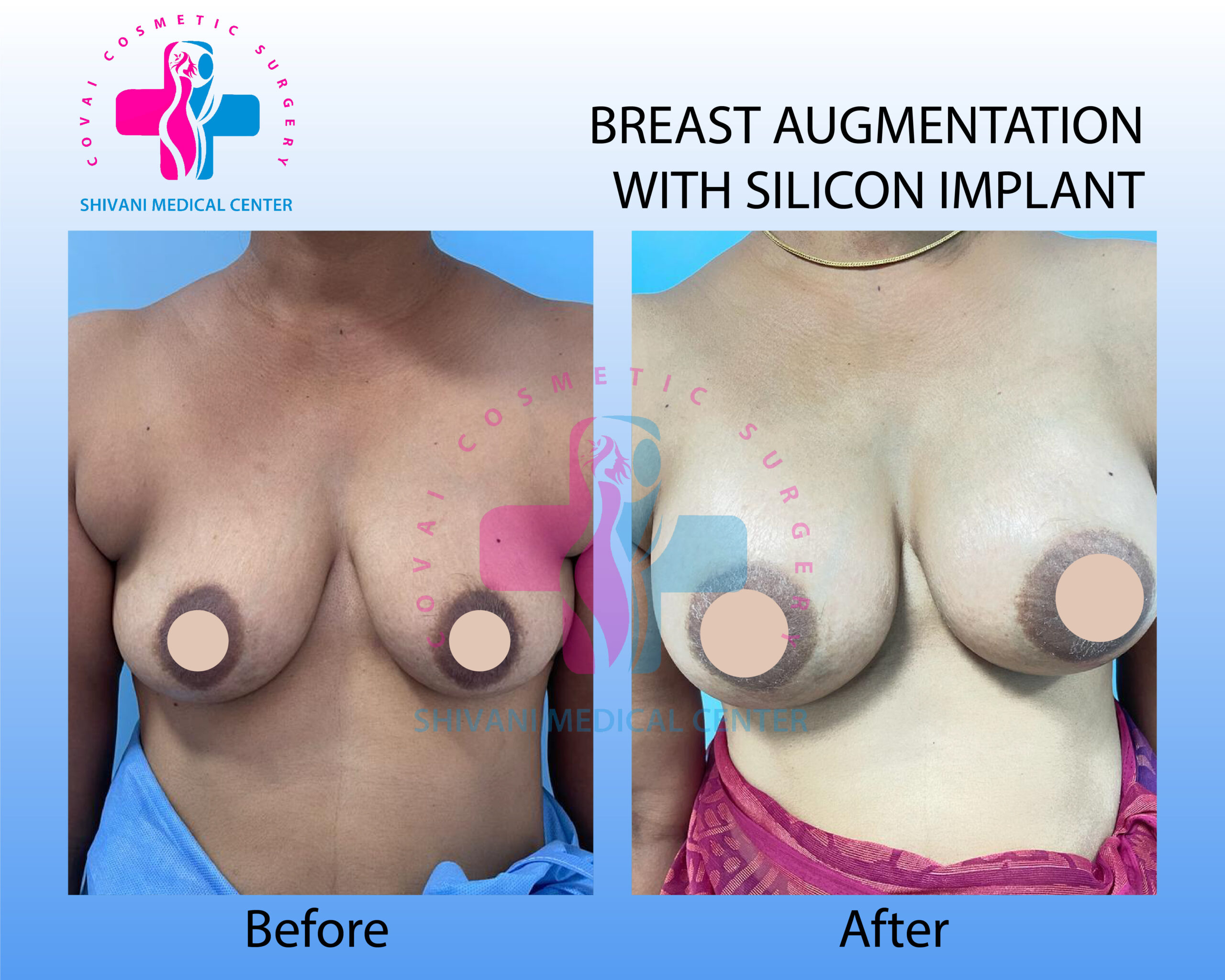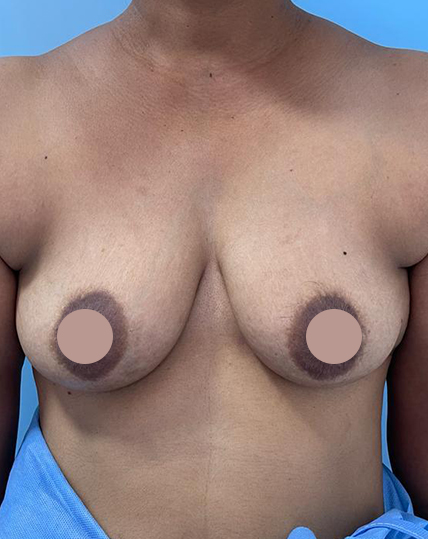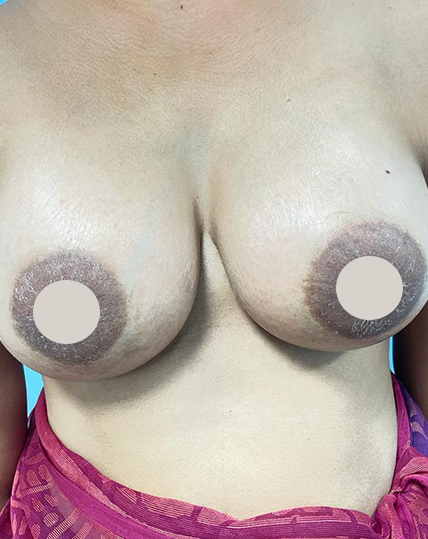Breast Implants
- Home
- Breast Implants

Breast Implants Cost in Coimbatore
Also known as Chest enlargement or Chest enhancement surgery, the procedure of chest implant aims to reform, increase, enhance or regain the size of the chests and thus also aims to restore the balance of the figure. This is a much sought-after procedure in cosmetic surgery and it also has a good track record of safety, success, and satisfaction in most cases.
One may consider a chest implant surgery when they want to:
- Have a better-proportioned figure that is appealing.
- Reconstruct an absent chest either congenitally or due to a chest removal surgery (Mastectomy).
- If you want a better proportioned or more appealing figure and want clothes to fit better.
- To restore the shape when one chest looks a lot different from the other.
- When aging, chestfeeding, pregnancy or weight loss has affected the appearance of the chests.
Our Service
- Face Surgeries
- Body & Chest
- Hair Treatment
- Laser Treatment
- Anti Aging
- Aesthetics


What are the most common reasons for seeking chest implant surgery?
- When a woman feels that her chests are too small for her body.
- When clothes fit perfectly at the hips but are loose on the top.
- When one wants to have a shapely figure while wearing a swim-suit or low neckline dresses and have firm chests.
- When one wants to regain the pre-pregnancy shape of the body.
- When one suffers from Poland Syndrome where one chest is absent or very small in comparison to the other chest
Procedure of chest implant surgery
In this procedure, the surgeon will make an incision and make a pocket underneath the chest tissue to place the implants. The implants are then placed in this tissue and the incision is closed, most commonly with absorbable sutures.
The different types of incisions in practice that can be made to place the implants are:
- Inframammary: In the chest crease underneath the chest. Transaxillary: Near the arm-pit.
- Transaxillary: Near the arm-pit.
- Periareolar: halfway around the black area surrounding the nipple.
- Transumbilical: In the belly-button/navel (Only for Saline implants)
The planes where the implants can be placed under the chest may be behind the gland or behind the muscle. The surgeon is the best person to suggest where should the implants be placed depending on certain factors which are best discussed after the physical examination.
Implant with fat
In this method, the fat from one’s own body for e.g. the thighs, the abdomen or the buttock is used. The fat is harvested by the method of liposuction, filtered and purified for injection and the fat is inserted at different planes of the chest through injections. This can be considered a virtually scar-less technique. This method is still in its evolution phase, although it has shown much promise. A chest lift may be combined with any of these procedures if the chests are droopy and need a lift as well as volume.
Are chest implants safe?
The USFDA has approved the usage of silicone implants in chest enhancement surgeries. It is important for women having chest implants to know that although the implants last quite long, it may need to be replaced.
One must stay in touch with her aesthetic surgeon to have periodic examinations and checks and must report in case of any change that seems to require attention like sudden swelling and pain in the chest after the implant.
What are my options for different types of implants?
There have never been more choices for chest implants. The following options are available, depending on your medical history, body shape and aesthetic goals.
Silicone chest implants (gel-filled)
These are the most commonly used chest implants throughout the world. They are pre-filled with soft silicone gel in a silicone shell.
Silicone chest implants (cohesive gel)
These are pre-filled implants also called as gummy-bear or form-stable implants. The silicone gel used in these implants is more form-stable and are.
Saline chest implants
These implants have sterile salt water filled in them instead of silicone. They may be pre-filled or may be inflated after the implant has been placed in the pocket of the chest, hence the incision used for their placement is smaller than the silicone implant.
How do I prepare for my implant procedure?
Once you have had a consult with the Plastic Surgeon you would most likely be advised:
- A baseline mammogram or an ultrasound of the chests
- To quit smoking or at least stop it a couple of weeks before and after the surgery.
- To stop taking any blood thinners if you take it or to stop certain drugs that cause blood thinning.
- To keep up the water intake.
After the procedure
After the chest implant procedure, you will experience stretching and pain in the chests because of the chest tissue stretches while implant placement.
The chests may also be sensitive to touch and may be red and swollen. However, the discomfort subsides in a couple of days and gradually one can return to normal activities within a week.
You will also be advised to wear a support bra immediately after the surgery and you will be advised by your surgeon about the duration for which you would need to wear it, probably about 4-6 weeks.
Physical activity should be minimized for a couple of weeks and one must gradually increase the level of physical exertion. Intimate contact with your partner will be guided by your recovery from the procedure.
In the long term, you will need to stay in touch with your surgeon and have periodic checkup every few years and have repeated mammograms (recommended otherwise too for women after a certain age).
Limitations and Risks
Fortunately, significant complications from chest implants are infrequent. Your specific risks for chest implants will be discussed during your consultation.
All surgical procedures have some degree of risk. Some of the potential complications of all surgeries are:
- Adverse reaction to anesthesia
- Hematoma or seroma (an accumulation of blood or fluid under the skin that may require removal)
- Infection and bleeding
- Changes in sensation
- Scarring
- Allergic reactions
- Damage to underlying structures
- Unsatisfactory results that may necessitate additional procedure
All surgical procedures have some degree of risk. With chest implants, minor complications occur occasionally but do not affect the outcome. Major chest implants complications are very unusual.
Other risks specific to chest implants are outlined below:
Other risks specific to chest implants are outlined below:
- Infection
- Capsular contracture
- Implant rupture
- Mammography shadows affecting chest cancer detection.
Associated Costs
- The cost of chest implant surgery would depend on factors like surgeon, geographic area, implant choice etc.
- Insurance does not cover the surgery.
- One should choose her surgeon based not only on cost but also on experience, training and one’s comfort with the surgeon.
Implants and ALCL
In the January of 2016, the USFDA observed and confirmed that women with chest implants may be at an increased risk of BI-ALCL, this is not chest cancer and neither is it a cancer of the chest tissue. It is cancer arising in the capsule of the implant and is a very rare type of non-Hodgkins lymphoma. This can be easily detected and is highly treatable in the majority.
In women who develop this cancer, the implant should be immediately removed. Women with chest implant should continue their routine chest
In women who develop this cancer, the implant should be immediately removed. Women with chest implant should continue their routine chest examinations as recommended for other women.
The USFDA and the Institute of medicine still believe that chest implants are fairly safe and effective.
